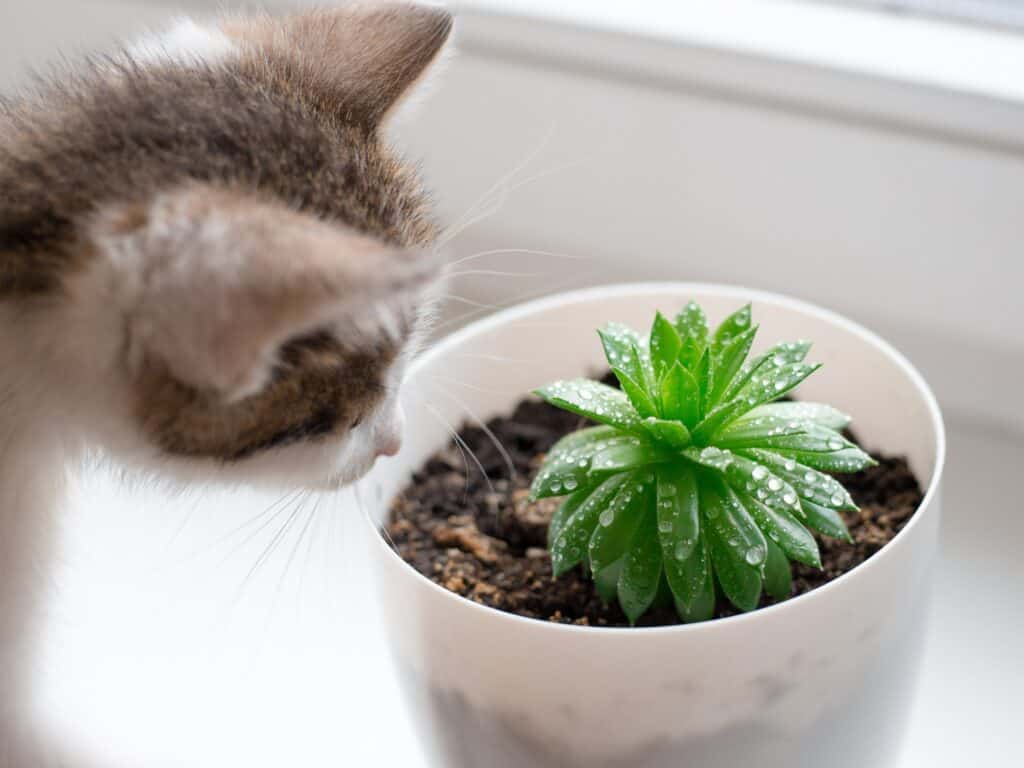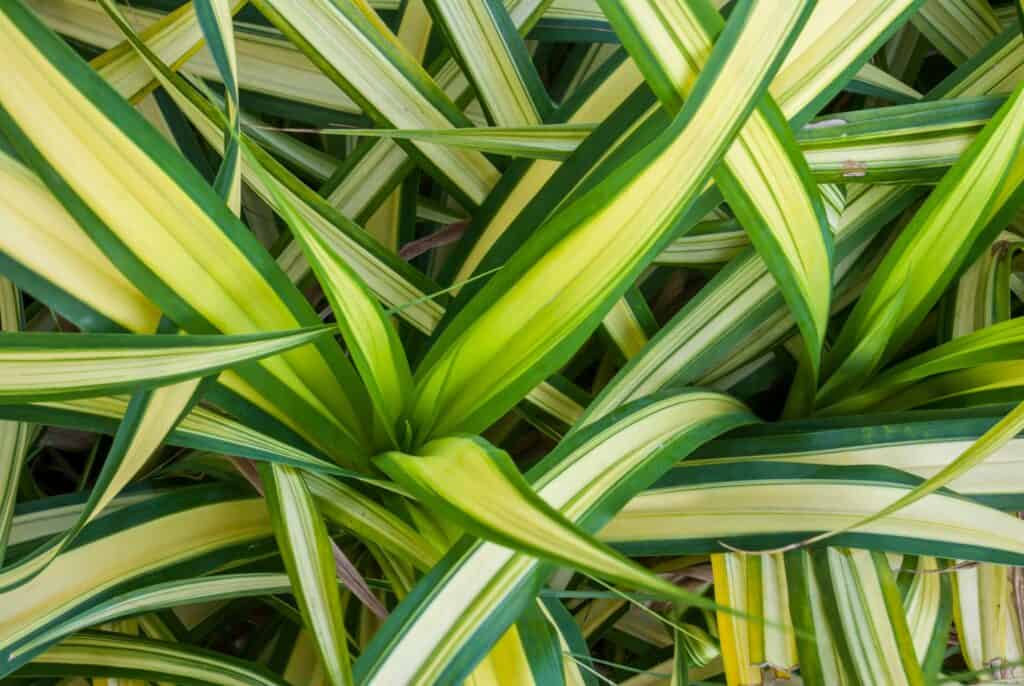Last updated on March 8th, 2024 at 10:55 am
Spider plants, scientifically known as Chlorophytum comosum, are among the most popular houseplants due to their low maintenance and ability to thrive in indirect light. With their long leaves and pattern of growth, they make a great addition to any room’s aesthetic, whether perched on a high shelf or hanging in a beautiful planter.
But there’s one question that gives many cat owners pause: are spider plants toxic to cats? Let’s dig into the facts and find out.
Are Spider Plants Toxic To Cats: Understanding Why Cats Are At Risk
Cats have a unique physiology, including a distinctive metabolic system. They lack certain enzymes needed to break down some of the compounds found in plants and other substances.
For example, they lack the liver enzyme necessary to break down and eliminate compounds like phenols and terpenes – volatile aromatic compounds that are often found in essential oils and the plants from which they are derived.
There are many things that are safe for humans but are poisonous to cats, and this includes houseplants. Each plant has its own set of chemical compounds that may affect cats differently.
Some can be harmless, while others can cause serious health issues. The severity of symptoms depends on the nature of the plant and the amount ingested. Cat owners need to be aware of which plants are safe for their feline friends and which ones could be risky.
Why Cats Love Spider Plants
Cats are naturally attracted to spider plants. It’s quite common to find cats batting at the leaves or trying to take a nibble. I personally have never been able to have both—whichever spider plant comes into my home sooner or later falls victim to my cat’s curiosity.!
The long, hanging leaves can trigger a cat’s instinct to play and hunt. The small ‘pups’ that grow from the parent plant also create a dangling temptation, perfect for swatting or nibbling.
The texture of the leaves adds to the appeal, offering a satisfying crispness that some cats enjoy chewing on. This behavior may be linked to the fact that spider plants mildly resemble grass, and cats often consume grass for its natural laxative effect.
The Truth About Spider Plant Toxicity
Here’s the good news: According to the ASPCA (American Society for the Prevention of Cruelty to Animals), spider plants are not considered toxic to cats or dogs. They are listed among non-toxic plants for pets, a sigh of relief for plant enthusiasts who are also devoted pet parents.
There have been anecdotes suggesting that spider plants may have a mild hallucinogenic effect on cats, akin to the response some cats have to catnip. In reality, there isn’t solid scientific evidence to support these claims.
However, despite being a safe choice, these common indoor plants can still cause an upset stomach in some cats if they decide to snack on them. Signs of spider plant indigestion in a cat include:
- Vomiting
- Diarrhea
- Drooling
If your cat shows any of these symptoms after nibbling on a spider plant, it’s best to monitor them closely and consult with your veterinarian if the symptoms persist or worsen. In most cases, the symptoms will resolve on their own within a few hours.

Safe Plants For Cats
Creating a safe, healthy environment for our four legged family members while still enjoying our greenery is possible. There are many other plant options that are safe for cats. A few for you to consider having in your home include:
- Boston ferns
- Calatheas
- Hens and chicks
- Orchids
- African Violets
- Parlor Palm
- Bamboo Palm
- Banana
Plants To Avoid
On the other hand, certain popular indoor plants can pose potential risks. Popular houseplants range in toxicity, depending on the species of plant and sometimes the part that is ingested, causing signs of poisoning ranging from mild gastrointestinal upset to serious conditions like liver failure.
Here’s a list of 11 common houseplants to steer clear of if you have cats in in your home:
- Lilies (Lilium spp.) – Not all lily species are equally toxic, but all lilies are poisonous to cats to some extent and should be avoided.
- Dieffenbachia (Dumb Cane) – This plant’s leaves contain calcium oxalates which can cause oral irritation and difficulty swallowing.
- Philodendron spp. – Similar to Dieffenbachia, containing oxalates leading to serious mouth and throat irritation and difficulty swallowing.
- Oleander (Nerium oleander) – All parts of the Oleander plant are toxic, and ingestion can lead to severe cardiac issues and death.
- Azaleas and Rhododendrons (Rhododendron spp.) – Eating just a few leaves can cause severe toxicity; without immediate veterinary attention, it can be fatal.
- Cyclamen (Cyclamen spp.) – The roots of this plant are especially poisonous, causing intense vomiting and even death.
- Yew (Taxus spp.) – Contains compounds that can lead to tremors, difficulty breathing, and heart failure.
- Daffodils (Narcissus spp.) – The bulbs contain lycorine, an alkaloid with strong emetic properties (causes vomiting).
- Tulips (Tulipa spp.) – The bulb is the most toxic part, causing oral irritation, drooling, and nausea.
- Asparagus Fern (Asparagus aethiopicus) – May cause allergy-like reactions and gastrointestinal upset.
- Fig (Ficus spp.) – Their the white, milky sap contains proteolytic enzymes that can cause irritation and inflammation when it comes into contact with the skin or mucous membranes
Always consult with a veterinarian immediately if you suspect your cat has ingested a potentially toxic plant, or (in North America) contact the Pet Poison Helpline at 1-855-764-7661
Keep in mind that these are just a few of the plants that can be potentially deadly to cats. The list is long, and we encourage you to head on over to ASPCA’s lists of safe and toxic plants for cats and do your research before bringing a new houseplant home.
Keeping Houseplants Safe From Cats
The best way to prevent unwanted nibbling on any houseplant is keeping them out of your cat’s reach. This could mean placing plants on high shelves or using hanging planters.
Make sure that hanging plants are located away from furniture or other items that the cat can use to climb close enough to reach the plant. Anticipate that your cat will make a jump for it, if it thinks it can make it!
You can also try a cat-safe repellent spray on the plants you want to keep your cat away from. These sprays are available at most pet stores and use non-toxic, natural ingredients to discourage cats from exploring the plant.
For those who are also plant parents, investing in some indoor cat grass can provide a safe alternative for curious cats to graze upon.

Final Thoughts
It’s no secret that cats and indoor plants often don’t mix well. While the spider plant is a non-toxic indoor plant, our curious feline friends can still cause a little mischief with hanging baskets.
As a pet owner and plant lover, it’s important to know which plants are safe for cats. Whether you’re a new plant parent or experienced in indoor greenery, it’s always a good idea to explore the list of plants recommended by organizations like the ASPCA Animal Poison Control Center before bringing new plants into a home with pets.
For more information and resources on pet-safe gardening, or if you suspect your cat may have ingested something toxic, the Pet Poison Helpline or your local vet can offer guidance.
Creating harmony between our love for plants and our duty to our pets is not just possible, it’s a testament to responsible and loving pet care.
Disclaimer: This article is intended for informational purposes only, and does not constitute medical advice. Always consult your veterinarian if you have specific concerns about your pet’s health.

